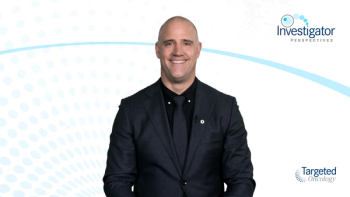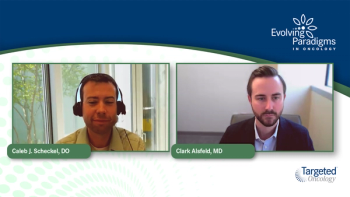
Lenvatinib and Age
An expert explains the impact of patient age when taking lenvatinib for treatment.
Episodes in this series

Marcia S. Brose, MD, PhD: When the SELECT trial was first published and I was talking to many of my colleagues because of the concern of the number of people who had grade 3 hypertension, many of the patients that were over 65, the doctors that I spoke to said, “I’m not going to give it to those patients. I’m not comfortable with it. I’m worried that they’re too frail and it’ll be too rough.”
What was interesting about going back to the data from the SELECT study in a pre-planned analysis—this part of the study design was when we stratified for patients who were under 65 and over 65 and looked at the data—it turned out that the patients over 65, actually had an overall survival advantage to being treated with lenvatinib [Lenvima] vs placebo. This really turned people’s biases on their heads. They had a bias to say, “Oh, these patients can’t tolerate it.” But in fact, they were actually the patients who seemed to be in a way benefiting the most. Yes, because of comorbidities and because of slightly elevated blood pressures, they had a little bit more opportunity or more cause to have dose reductions. But with that, they still did better overall, so we were not able to say that it was a secondary effect of anything. It really just seemed to be straight up. Lenvatinib was clearly beneficial in these patients and actually resulted in a full overall survival statistically significant result. The data for this was actually published in 2017 in the Journal of Clinical Oncology. And I refer you to that paper in case that would help.
Did this study change the way I use lenvatinib? Absolutely, and it definitely changed the minds of many of my colleagues who are holding it back in any of their older patients. I think if you have anybody of any age that looks like they are with it and able to participate in managing the toxicities with you, and they’re not already maxed out on their hypertension medicine, you should be thinking about giving them lenvatinib.
This transcript has been edited for clarity.
Case: A 70-Year-Old Woman With Differentiated Thyroid Cancer
Initial presentation
- A 70-year-old woman presents with a painless “lump on her neck.”
- PMH: unremarkable
- PE: palpable, non-tender solitary right-of-the midline neck mass; otherwise unremarkable
Clinical workup and initial treatment
- Labs: TSH WNL
- Ultrasound of the neck revealed a 3.4 cm suspicious right mass arising from the right thyroid; 4 suspicious supraclavicular lymph nodes (LNs), largest 2.2 cm in size.
- Ultrasound-guided FNAB of the thyroid mass and the largest LN confirmed papillary thyroid carcinoma.
- Patient underwent total thyroidectomy with central compartment and right selective neck dissection.
- Pathology: 3.4 cm papillary thyroid cancer arising in the right lobe of thyroid, tall-cell features; extrathyroidal extension present;
- 2 of 6 positive central compartment lymph nodes, largest 1.8 cm
- 4 of 13 right lateral compartment involved nodes largest 2.2 cm in size, positive extra nodal extension.
- StageT2N1aMX; ECOG PS 0
Subsequent treatment and follow-up - She was treated with radioactive iodine 150 millicuries
- Whole body scan showed uptake in the neck, consistent with thyroid remnant but no uptake in the lungs
- Follow-up at 3 months
- TSH 0.2 µU/mL, thyroglobulin 28 ng/mL (negative anti-thyroglobulin antibodies)
- Chest CT scan showed 8 small bilateral lung nodules largest 1.3 cm
- Follow-up CT neck and chest scan 3 months later was notable for 1-2mm growth in several lung nodules and 3 new distinct 9.5 mm lung nodules
- Next-generation sequencing was negative for mutations, rearrangements
- Lenvatinib 24mg po qd was initiated
Case 2: A 57 Year-Old Man With Differentiated Thyroid Cancer
Initial presentation
- A 57-year-old man presents with a solitary nodule on the neck and occasional shortness of breath and intermittent excessive fatigue
- PMH: unremarkable
- PE: palpable, hard and fixed solitary nodule in the anterior neck
Clinical workup and initial treatment
- Labs: TSH 10.3 µU/mL; all others WNL
- Ultrasound of the neck revealed a 2 cm mass near the isthmus of the thyroid; several suspicious lymph nodes ranging from 0.3-2.4 cm in size
- Ultrasound-guided FNAB: confirmed papillary thyroid carcinoma; with nuclear enlargement and nuclear grooves, no colloid seen
- Patient underwent total thyroidectomy with bilateral central neck dissection
- Pathology: 2.1 cm papillary thyroid cancer arising in isthmus of the thyroid, 3 of 7 positive central compartment lymph nodes, largest 1.8 cm, positive extra nodal extension
- StageT2N1MX; ECOG PS 1
Subsequent treatment and follow-up
- He was treated with radioactive iodine 150 millicuries
- Whole body scan showed uptake in the neck; indicative of thyroid remnant
- Follow-up at 3 months TSH 0.2 µU/mL, thyroglobulin 68 ng/mL
- Neck US showed no evidence of residual disease in thyroid bed, no suspicious neck nodes. Chest CT was done: 4 lung lesions that were 0.3 and 0.6 cm in size
- The physician recommended not initiating systemic therapy and putting the patient on active surveillance








































